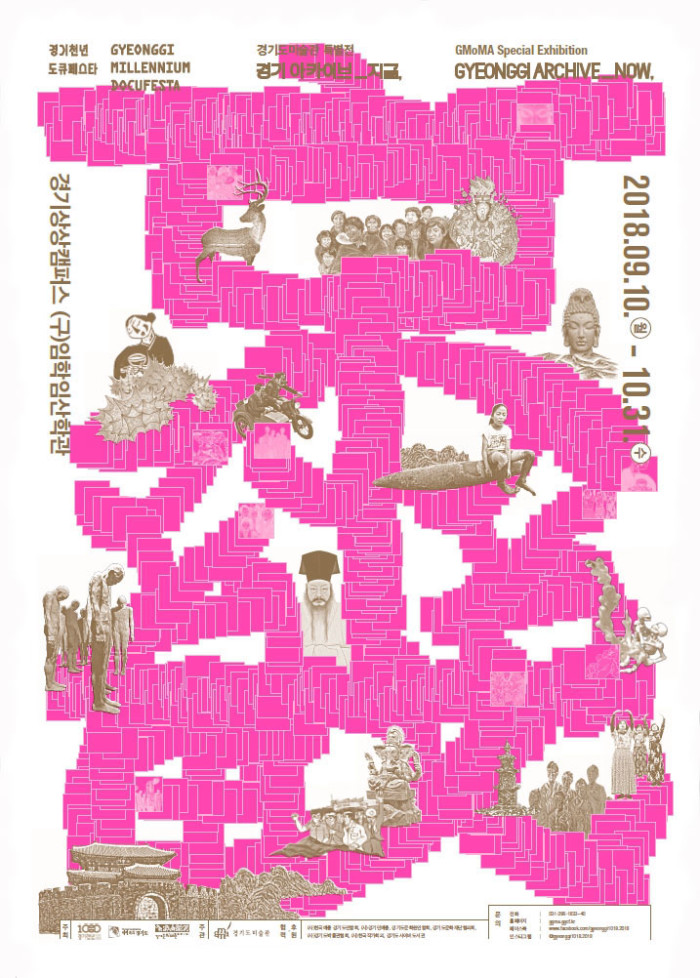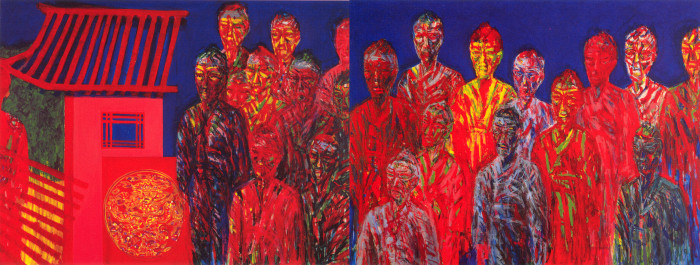경기문화재단
Gyeonggi Millennium Docufesta, “Gyeonggi Archive_Now,”
2018-09-10 ~ 2018-10-31 / Gyeonggi Museum of Modern Art
For more information about , visit the Gyeonggi Art Museum at(gmoma-en.ggcf.kr) |
Gyeonggi Millennium Docufesta, “Gyeonggi Archive_Now,” Exhibition Open
▶ The First Docufesta, Where You Can Find the History, Arts, Records, and Memories of the Gyeonggi Millennium
The exhibition <Gyeonggi Archive_Now,>, organized by Gyeonggi Province and the Gyeonggi Cultural Foundation and supervised by the Gyeonggi Museum of Modern Art, is being held from September 10 to October 31 at Gyeonggi Sangsang Campus.

To celebrate the naming of the province as “Gyeonggi (京畿),” this exhibition, designed as a special exhibition of GMoMa, allows visitors to look into a variety of cultures and creative art in one place. Also, massive data on art and culture has been collected to compile a “New Gyeonggi Millennium Uigwe” revealing the cultural identity of Gyeonggi. “Uigwe” is originally an illustrated record of national rituals from the Joseon Dynasty. As a matter of fact, a “Gyeonggi Archive Book” will be compiled through this exhibition.

“_Now,” the subject of the exhibition, is a notion that implies the past, the present, and the future of Gyeonggi Province. “Now” is challa—an instant moment when an event happens or a state is brought about. In Buddhism, it is said that everything appears and disappears, and disappears and appears in a single challa. It refers to the moment “here and now.” The “millennium” of te Gyeonggi Millennium is also comprised of the moments of challa. To open the future of Gyeonggi means to go beyond those moments. Thus, “connecting the moments (_)” and examining them with a “comma (,)” is the subject of this exhibition.

The major works to be displayed: 300 plus pieces of paintings, photos, sculptures, videos, and installations devoted to Gyeonggi Province or created by the 150 artists who have their studio in Gyeonggi Province; 1,000 plus data on the activities of small art groups in Gyeonggi Province since the 1980s; 100 books on modern woodblock; 20 plus documents on modern pop music; 100 plus first editions of literature; and 2,000 plus books on history, art, folk, human beings, local community, cultural assets, philosophy, paintings, and old maps.

The exhibition is organized into eight parts: 1) Literature_Writing, 2) Visual Art_Drawing, 3) Cultural Properties_Enticing, 4) Philosophy and Series_Loving, 5) Performance and Festival_Playing, 6) Records_Collecting, 7) Nature and Environment_Flowing, and 8) Gyeonggi Residents_Living. The details are as follows:
◦ Part 1 | Literature_Writing, |
- Literature geography of Gyeonggi Province in a glance, based on 『Gyeonggi Literature Map (vol. 1, 2)』, 『Bringing Back the Memory of the Place: Literature Geography of Gyeonggi Province』, 『Birth of Place: the Literature Geography of Our City』 - An assorted exhibition space with works of over 100 major writers of 31 cities and counties - Based on the collections and special editions published by Gyeonggi Writers Association and Gyeonggi Literature Council - Handwritten manuscripts, photos of writers, video interviews investigated and collected |
◦ Part 2 | Visual Art_Drawing, |
- 300 plus paintings, sculptures, photos, videos, media, installations of 150 artists on show - A separate ‘Artist Archive’ space with the art catalogues of the artists and Gyeonggi art history books - Records for 15 years of six spaces that belong to Gyeonggi Alternative Art Space Network on display - Activities of small art groups to shed light on the contemporary art of Gyeonggi examined, collected, and displayed |
◦ Part 3 | Cultural Properties_Enticing, |
- Largely based on 『Gyeonggi Cultural Properties Ⅰ․Ⅱ』 which was published by Gyeonggi Province in December 2017 - Records of Gyeonggi Intangible Cultural Properties (skill/art) investigated and displayed - Photos, catalogues, and videos of Gyeonggi Intangible Cultural Properties Association on show - Demonstration of ‘Gut of Gyeonggi-do,’ display of paintings and tools of gut and Buddhist paintings |
◦ Part 4 | Philosophy and Series_Loving, |
- After running the project of the biography publication on great figures of Gyeonggi-do and making the investigation on academic books like 『Gijeon Art and Culture Collection』 (“gijeon” is the old name of Gyeonggi-do), 『Silhak Research Collection』 that enable us to look into the philosophy of Gyeonggi-do, we displayed each book with “net knot bookmark” to make it easily accessible by the residents ※ “saranghada (now meaning to love)” meant in early Korean “to think” or “to consider” - Introduction of “Gyeonggi Great Books 100 Delivering Radiant Spiritual Culture of the Gyeonggi Millennium” (associated with the Cultural Project Team) |
◦ Part 5 | Performance and Festival_Playing, |
- Data (photos, videos, and documents) on 15 great festivals in Gyeonggi-do on display - Allowing visitors to grasp the new identity of the 21st-century culture of Gyeonggi-do through the literature on the performance and festival - Exhibition of documents on the modern history of the theater of Gyeonggi-do, including that of Suwon |
◦ Part 6 | Records_Collecting, |
- Making archive of Gyeonggi Millennium Project 2017-2018 - Modern pop music archive (22), books on modern woodblock (100), first editions of literature (100 plus) - Archive report of Gyeonggi Bukbu Village, Art and Culture Project Data of Gyeonggi - Documents of museums belonging to Gyeonggi Cultural Foundation, documents of The Federation of Gyeonggi-do Cultural Center, Gyeonggi-do Branch of The Federation of Artistic & Cultural Organization of Korea, Gyeonggi Branch of Korea National Artists General Federation, and Museums belonging to The Gyeonggi-do Museum Association - Old records including old Maps of Gyeonggi Province, 『Place Name and Dialect of Seoul and Gyeonggi Region』, Gyeonggi culture map |
◦ Part 7 | Nature and Environment_Flowing, |
- Records on mountains, rivers, plains, islands, bays, seas, DMZ, and cities of Gyeonggi-do ※ Including archive photos and videos 2017-2018 |
◦ Part 8 | Gyeonggi Residents_Living, |
- Exhibition of ‘Gyeonggi Residents’ who lived and are living here and now in Gyeonggi-do ※ Media-time-capsule-type archive device installed in the exhibition hall ▷ Real time up-date with the participation of visitors |
Gyeonggi Millennium Gyeonggi Millennium indicates that it has been a thousand years since our province was named “Gyeonggi (京畿).” According to the chronicle of Wanggyeong Gaeseongbu written in the Geography Section of Goryeosa (History of Goryeo), the reform of the administrative institution was made in 1018 under the reign of King Hyeonjong in the Goryeo Period. It was by then that the capital Gaegyeong and its surrounding 12 counties and districts started to be collectively called “Gyeonggi.” The year 2018 is the 1,000th anniversary of the birth of Gyeonggi. The year 1018, on the other hand, is the year when the policy called Gyeonggije started and the culture of Gyeonggi emerged. Gyeonggi Millennium Docufesta ‘Gyeonggi Millennium Docufesta’ is a representative brand of the Gyeonggi Millennium Project, which was planned by Gyeonggi Province and the Gyeonggi Cultural Foundation in celebration of the 1,000th anniversary of the region’s naming. It is an artistic brand for both recording the past and the present and for preparing for the future, encompassing various projects including the Gyeonggi Archive, the Gyeonggi 1018-2018 Festival, and the Imagination Platform of Policy for Gyeonggi Residents. |
<ggc의 모든 콘텐츠는 저작권법의 보호를 받습니다.>
세부정보
Gyeonggi Millennium Docufesta, “Gyeonggi Archive_Now,”
Period/ 2018.09.10–2018.10.31
Venue/ Gyeonggi Sangsang Campus
Supervisor/ Gyeonggi Museum of Modern Art
Inquiries/ 031-296-1840